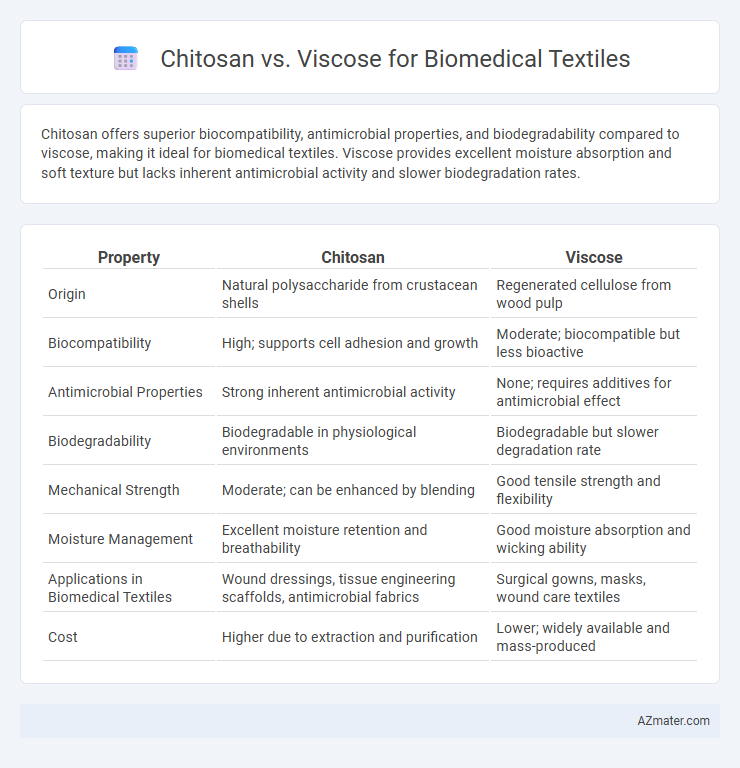Chitosan offers superior biocompatibility, antimicrobial properties, and biodegradability compared to viscose, making it ideal for biomedical textiles. Viscose provides excellent moisture absorption and soft texture but lacks inherent antimicrobial activity and slower biodegradation rates.
Table of Comparison
| Property | Chitosan | Viscose |
|---|---|---|
| Origin | Natural polysaccharide from crustacean shells | Regenerated cellulose from wood pulp |
| Biocompatibility | High; supports cell adhesion and growth | Moderate; biocompatible but less bioactive |
| Antimicrobial Properties | Strong inherent antimicrobial activity | None; requires additives for antimicrobial effect |
| Biodegradability | Biodegradable in physiological environments | Biodegradable but slower degradation rate |
| Mechanical Strength | Moderate; can be enhanced by blending | Good tensile strength and flexibility |
| Moisture Management | Excellent moisture retention and breathability | Good moisture absorption and wicking ability |
| Applications in Biomedical Textiles | Wound dressings, tissue engineering scaffolds, antimicrobial fabrics | Surgical gowns, masks, wound care textiles |
| Cost | Higher due to extraction and purification | Lower; widely available and mass-produced |
Introduction to Biomedical Textiles
Biomedical textiles incorporate advanced materials like chitosan and viscose to enhance biocompatibility, antimicrobial properties, and tissue regeneration. Chitosan, derived from chitin, offers natural antibacterial effects and promotes wound healing, making it ideal for sutures and wound dressings. Viscose, a regenerated cellulose fiber, provides excellent moisture absorption and softness, supporting comfort and effective skin interaction in medical textiles.
Overview of Chitosan-Based Textiles
Chitosan-based textiles exhibit remarkable biocompatibility, biodegradability, and antimicrobial properties, making them highly suitable for biomedical applications such as wound dressings and tissue engineering scaffolds. Their ability to promote cell adhesion and accelerate healing processes distinguishes chitosan from viscose, which primarily offers moisture management without inherent bioactivity. Innovations in chitosan fiber modification enhance mechanical strength and durability, addressing previous limitations compared to viscose-based materials in medical textile uses.
Key Characteristics of Viscose in Biomedical Applications
Viscose fibers exhibit high biocompatibility and enhanced moisture absorption, making them ideal for biomedical textile applications such as wound dressings and surgical gowns. Their biodegradability and soft texture contribute to patient comfort while reducing environmental impact. Furthermore, viscose's ability to be chemically modified allows for incorporation of antimicrobial agents and improved cell adhesion properties.
Biocompatibility: Chitosan vs Viscose
Chitosan exhibits superior biocompatibility compared to viscose due to its natural origin, antimicrobial properties, and ability to promote cell adhesion and tissue regeneration, making it highly suitable for biomedical textiles. Viscose, while biocompatible and widely used, lacks inherent antimicrobial activity and may require chemical modification to achieve similar performance. The molecular structure of chitosan enables enhanced interaction with biological tissues, providing better wound healing and reduced inflammatory response.
Antimicrobial Properties Comparison
Chitosan exhibits superior antimicrobial properties compared to viscose, effectively inhibiting a broad spectrum of bacteria, fungi, and viruses due to its positively charged amino groups that disrupt microbial cell membranes. In contrast, viscose lacks inherent antimicrobial activity and often requires chemical treatments or coatings to achieve similar effects, which may compromise fabric biocompatibility. The natural biodegradability and biocompatibility of chitosan make it more suitable for biomedical textiles requiring sustained antimicrobial efficacy and reduced risk of infection.
Mechanical Strength and Durability
Chitosan exhibits superior mechanical strength and durability compared to viscose, making it highly suitable for biomedical textiles that require long-term performance. Its biopolymer structure provides enhanced tensile strength and resistance to wear, while viscose, derived from cellulose, tends to degrade more rapidly under physiological conditions. Chitosan's capability to maintain integrity under mechanical stress contributes to improved longevity and functional reliability in wound dressings and tissue engineering applications.
Moisture Management and Breathability
Chitosan fibers exhibit superior moisture management due to their high hydrophilicity and antimicrobial properties, which prevent bacterial growth and enhance skin comfort in biomedical textiles. Viscose offers excellent breathability because of its porous fiber structure, facilitating efficient air and moisture vapor transmission. Combining chitosan's moisture absorption with viscose's ventilation capabilities creates an optimal balance for advanced moisture control and breathability in wound dressings and surgical garments.
Biodegradability and Environmental Impact
Chitosan fibers exhibit superior biodegradability compared to viscose, as they naturally decompose through microbial action without releasing harmful residues, making them ideal for sustainable biomedical textiles. Viscose, derived from cellulose but chemically treated, decomposes slower and can contribute to environmental pollution due to residual processing chemicals. The environmental impact of chitosan is significantly lower, benefiting from its renewable source in crustacean shells and minimal chemical processing, whereas viscose production demands intensive chemical use and generates higher waste.
Cost and Scalability in Biomedical Production
Chitosan offers excellent biocompatibility and antimicrobial properties but comes with higher production costs due to complex extraction from crustacean shells, limiting scalability in biomedical textile manufacturing. Viscose presents a more cost-effective and scalable option with its abundant raw materials and established industrial processes, making it suitable for large-scale biomedical textile production. However, viscose lacks the inherent bioactive features of chitosan, often requiring additional treatment to meet biomedical standards.
Future Prospects and Innovations
Chitosan, derived from crustacean shells, offers remarkable biocompatibility, biodegradability, and antimicrobial properties, positioning it as a leading candidate for next-generation biomedical textiles aimed at wound healing and tissue engineering. Viscose, a regenerated cellulose fiber, provides excellent moisture management, comfort, and cost-effectiveness, but future innovations focus on enhancing its functionalization with bioactive agents to match the biofunctional capabilities of chitosan-based materials. Emerging hybrid composites combining chitosan and viscose are expected to revolutionize biomedical textiles by synergizing antimicrobial efficacy and mechanical strength for advanced healthcare applications.

Infographic: Chitosan vs Viscose for Biomedical textile
 azmater.com
azmater.com